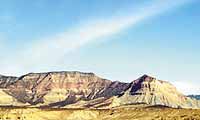So far this winter Mother Nature seems determined to remind everyone, just in case they forgot, that we live in a desert. A long dry winter has a great deal of hope resting on March being an unusually wet month, but with the month almost half over, the hope is quickly fading for many.
Emery County along with the rest of the state is bracing for what could be a very dry summer. With snowpack in the mountains at 60 percent of normal and a soil starved of moisture, area reservoirs will be far lower than normal this coming season, unless March proves to be a far wetter month than normal.
According to Jay Mark Humphrey of the Emery County Water Conservancy District, March is traditionally a good month for the county for snow-pack production, so while there is still a chance for the county to pull out of its water woes, people should expect a summer even dryer than last year.
“At this point we’re at 60 percent of normal with dry ground, so our end flows into the reservoirs will be just about nothing,” Humphrey said.
A plan to deal with what could be a far dryer than normal summer are pending, depending on how wet March proves to be. Humphrey said county irrigation companies will know better how to deal with the water situation in April, when the water levels for March are added into the equation.
While last year was a dry year, Humphrey said that the summer of 2002 could be even tougher.
Emery County is not alone in facing a shortage of water this year. Water conservation experts met March 5 on Capitol Hill to discuss Utah’s water shortage and to provide suggestions on how to start conserving water now. State Representative Carl Saunders, R-Odgen, hosted the event.
“When I was made aware that Utah would experience a drought for the fourth year in a row, I thought it would be worthwhile to bring these experts together and discuss the drought,” said Saunders. “We need to make the public aware of this problem, and take the necessary steps to combat this before it is too late.”
D. Larry Anderson, Director of Utah Division of Water Resources, Don Jensen, State Climatologist and Director of Utah Climate Center, and Mark Eubank, Chief Meteorologist for KSL Television, gave presentations.
The Division of Water Resources, along with the state’s water districts, expanded the “Slow the Flow; Save H2O” campaign last fall to stress the importance of water conservation, said Anderson.
“Our goal is to get the people of Utah to realize that we live in a desert, and we need to conserve water,” said Anderson. “We not only need to conserve water because we are in a drought, but we need to conserve water because it is the right thing to do.”
The state plans to continue the statewide campaign with a big kick-off this spring.
“We are in a drought,” Eubank, one of Utah’s leading meteorologists, said in a recent
Deseret News article. “In fact, if it keeps going, we’re in our fourth year of substandard snowpack.”
Utah’s reservoirs are only designed to supply the necessary water for two years, but with good management, the reservoirs have been spread out to accommodate three years, said Eubank.
“We do have a drought going on,” agreed Jensen. “The further south and the higher in the mountains you go, the more severe the drought is.”
A Long Dry Winter has Emery County Bracing for a Longer, Dryer Summer

